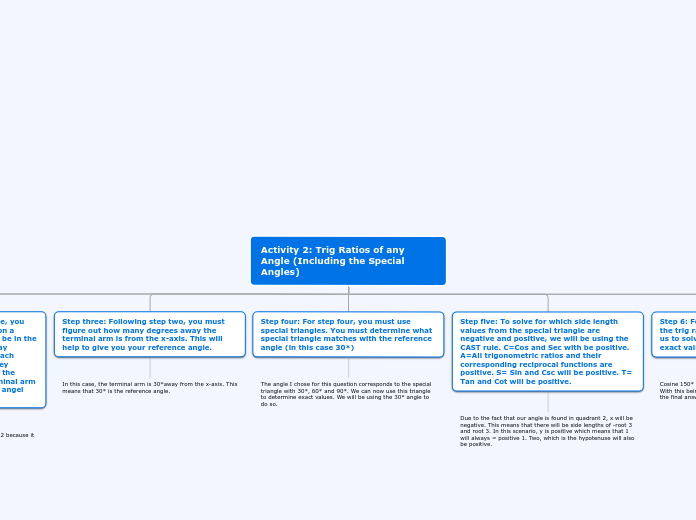Activity 2: Trig Ratios of any Angle (Including the Special Angles)
Step one: You must first convert the angle to degrees. This makes it much easier to draw. You can do this by multiplying it by 180/pi. This will help to start the question and set up a drawing of the angle measure.
Example: Cos(5pi/6). When multiplied by 180/pi it equals Cos150*
Step two: After completing step one, you will then draw the angle measure on a cartesian plan. Note that this must be in the correct quadrant. A person must pay attention to the degrees found in each quadrant when doing this. Once they determine which quadrant to draw the angle in, they must sketch the terminal arm to the correct degree and label the angel measure.
The angle from the example is found in quadrant 2 because it measures between 180*-270*.
Step three: Following step two, you must figure out how many degrees away the terminal arm is from the x-axis. This will help to give you your reference angle.
In this case, the terminal arm is 30*away from the x-axis. This means that 30* is the reference angle.
Step four: For step four, you must use special triangles. You must determine what special triangle matches with the reference angle (in this case 30*)
The angle I chose for this question corresponds to the special triangle with 30*, 60* and 90*. We can now use this triangle to determine exact values. We will be using the 30* angle to do so.
Step five: To solve for which side length values from the special triangle are negative and positive, we will be using the CAST rule. C=Cos and Sec with be positive. A=All trigonometric ratios and their corresponding reciprocal functions are positive. S= Sin and Csc will be positive. T= Tan and Cot will be positive.
Due to the fact that our angle is found in quadrant 2, x will be negative. This means that there will be side lengths of -root 3 and root 3. In this scenario, y is positive which means that 1 will always = positive 1. Two, which is the hypotenuse will also be positive.
Step 6: For the second step, we must use the trig ratios: SOHCAHTOA. This will allow us to solve the question and determine our exact values.
Cosine 150* = Cosine 30* (the cosine of the reference angle). With this being said cos30*= Adj/Hyp or -root3/2. Therefore, the final answer is -root 3/2.
